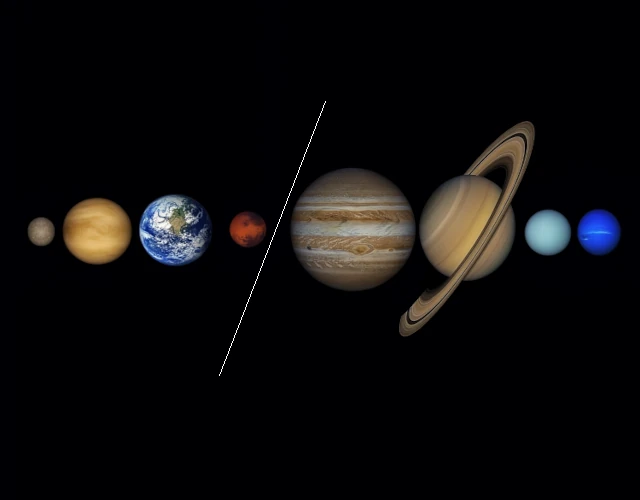
Have you ever noticed that each planet has its own color? Mercury is gray, Venus is yellowish-white, Earth is blue, Mars is red, Jupiter has orange bands, Saturn is golden yellow, Uranus is blue-green, and Neptune is deep blue.
The so-called terrestrial planets (Mercury, Venus, Earth, Mars) get their color from the light reflected directly from their surface or clouds.
The giant planets (Jupiter, Saturn, Uranus, Neptune) have no visible solid surface: their color comes from their cloudy and gaseous layers.
| Planet | Diameter / Earth | Main color | Main cause | Responsible composition |
|---|---|---|---|---|
| Mercury | 0.38 | Gray | Diffuse reflection of sunlight | Mercury, without atmosphere, faithfully reflects light on a dark basaltic soil, giving it a uniform gray tone. |
| Venus | 0.95 | Yellowish-white | Multiple scattering in an opaque atmosphere | Venus is wrapped in a thick layer of sulfuric acid clouds that scatter light and produce a yellowish-white glow. |
| Earth | 1.00 | Blue | Sunlight scatters in the air and reflects off the oceans | Earth owes its blue to its atmosphere of nitrogen and oxygen, which scatters blue light more than red, while its oceans enhance this hue. |
| Mars | 0.53 | Red | Selective reflection of the solar spectrum | Mars has dust rich in iron oxides that mainly reflects red wavelengths, giving the planet its characteristic color. It can appear more or less red depending on dust storms sweeping its surface. |
| Jupiter | 11.21 | Orange and white | Scattering in deep cloud layers | Jupiter has very contrasting colored bands, due to overlapping cloud layers of ammonia, sulfides, and phosphines that scatter light differently depending on their altitude and temperature. |
| Saturn | 9.45 | Golden yellow | Partial absorption of blue and scattering of yellow | Saturn, being colder, has more uniform hues, dominated by the golden yellow of its crystallized ammonia clouds and fine hydrocarbon hazes in its upper atmosphere. |
| Uranus | 4.01 | Blue-green | Absorption of red by methane | Uranus owes its pale blue-green color to the presence of methane, which preferentially absorbs red and infrared light. |
| Neptune | 3.88 | Deep blue | Stronger selective absorption of red | Neptune, on the other hand, displays a deeper blue due to a slightly higher concentration of methane and the likely presence of absorbing hazy particles in the upper layers of its atmosphere. |
Some planets show their true color thanks to what is on their surface. Mercury is gray like a stone because it is covered with dark rocks and has almost no air to change the light. Mars is red like rust because of its dust full of iron oxides, which mainly reflects the red rays of the Sun. Even Earth owes its colors to its surface: the green or brown continents and the blue oceans form a magnificent picture seen from space.
Other planets owe their color to their atmosphere, this layer of air or gas that surrounds them. Venus appears yellowish-white because its sulfuric acid clouds reflect and scatter a lot of sunlight. Jupiter and Saturn show colored bands, thanks to their clouds of ammonia and sulfur compounds that reflect light differently depending on their height. Uranus and Neptune are blue or blue-green: their atmosphere contains methane that absorbs red light, letting mostly blue pass through to our eyes. It's a bit like they're wearing giant blue glasses!